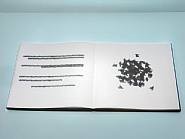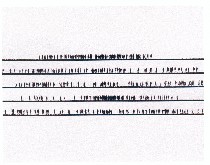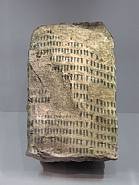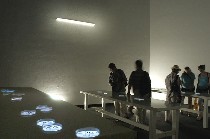
Post from Colette Copeland
Michal Rovner’s new video work at PaceWildenstein Chelsea challenges the syntax of video, embracing elements of history, archeology and language. Her retrospective at the Whitney last year included large multi-channeled projections and prints. In her current work, video comes off the wall and evolves into a sculptural realm. The first room contains internally illuminated glass cases, which at first glance appear to display open books. Upon closer examination, I discovered that the ‘supposed’ text was a video projection of tiny figures, devoid of any identity, reduced to moving silhouettes. The figures perform repetitive gestures, giving the appearance that the text is moving on the page (top, “Notebook”).
 In previous work, Rovner dealt with archetypes and universalities and the current work is no exception. This work is anti-identity or anti-individual. It is about any/every culture, any/every person and any/every time period throughout history. Immediately I am struck by the idea that the text continues to transform kinetically, referencing multiple perspectives of history. The title, “In Stone” plays upon the saying, “Set in Stone,” meaning permanence or stasis. Rovner’s work contradicts this idea. The subtle shifting of movement suggests that the passage of time manipulates how history is recorded, perceived, taught and learned. On a less intellectual note, I am also reminded of Harry Potter and how the people in the photographs are constantly moving.
In previous work, Rovner dealt with archetypes and universalities and the current work is no exception. This work is anti-identity or anti-individual. It is about any/every culture, any/every person and any/every time period throughout history. Immediately I am struck by the idea that the text continues to transform kinetically, referencing multiple perspectives of history. The title, “In Stone” plays upon the saying, “Set in Stone,” meaning permanence or stasis. Rovner’s work contradicts this idea. The subtle shifting of movement suggests that the passage of time manipulates how history is recorded, perceived, taught and learned. On a less intellectual note, I am also reminded of Harry Potter and how the people in the photographs are constantly moving.
The next room is also filled with glass cases. In lieu of books, the videos are projected onto stones. The objects resemble carved stone tablets, etched with hieroglyphics and symbols from ancient languages. In one piece, the figures are attached, moving in unison to a slow march. My eleven year-old daughter says they look like slaves. On another rock, the figures are wearing pointed hoods and cloaks, eerily simulating the KKK. The videos are silent, leaving the interpretation to the visual reading of the text.
A large stone basin/well sits in the center of a third darkened room. Projected onto sand in the bottom of the well are red swirling figures. The pace and rhythm of the video is more frenetic than in the other works. The shapes could be plague or bacteria disseminating into the air. It is as if a ritualized secret ceremony is occurring within the space.
 The last room contains large stone tablets half-buried in a room filled with sand. Images of the Ancient Egyptians or Moses and the stone tablets engraved with the Ten Commandments come to mind. The symbols are in flux between stasis and movement, performing prayer rituals. The sound emanates from every corner of the room, creating a sense of reverence and honor (right, “Afar”).
The last room contains large stone tablets half-buried in a room filled with sand. Images of the Ancient Egyptians or Moses and the stone tablets engraved with the Ten Commandments come to mind. The symbols are in flux between stasis and movement, performing prayer rituals. The sound emanates from every corner of the room, creating a sense of reverence and honor (right, “Afar”).
 Rovner states that her work is not about a specific political situation, but the work seems to speak about human struggles and the momentum with which humanity continues to persevere. She seamlessly blends her craft with conceptually complex ideas, leaving the viewer with enough room to imagine many interpretations (left, “Data Zone” shown at Venice Bienale). At PaceWildenstein, 534 West 25th St., NYC, until July 16th.
Rovner states that her work is not about a specific political situation, but the work seems to speak about human struggles and the momentum with which humanity continues to persevere. She seamlessly blends her craft with conceptually complex ideas, leaving the viewer with enough room to imagine many interpretations (left, “Data Zone” shown at Venice Bienale). At PaceWildenstein, 534 West 25th St., NYC, until July 16th.
–artblog contributor Colette Copeland is a multi-media artist who teaches at University of Pennyslvania and University of the Arts in Philadelphia









